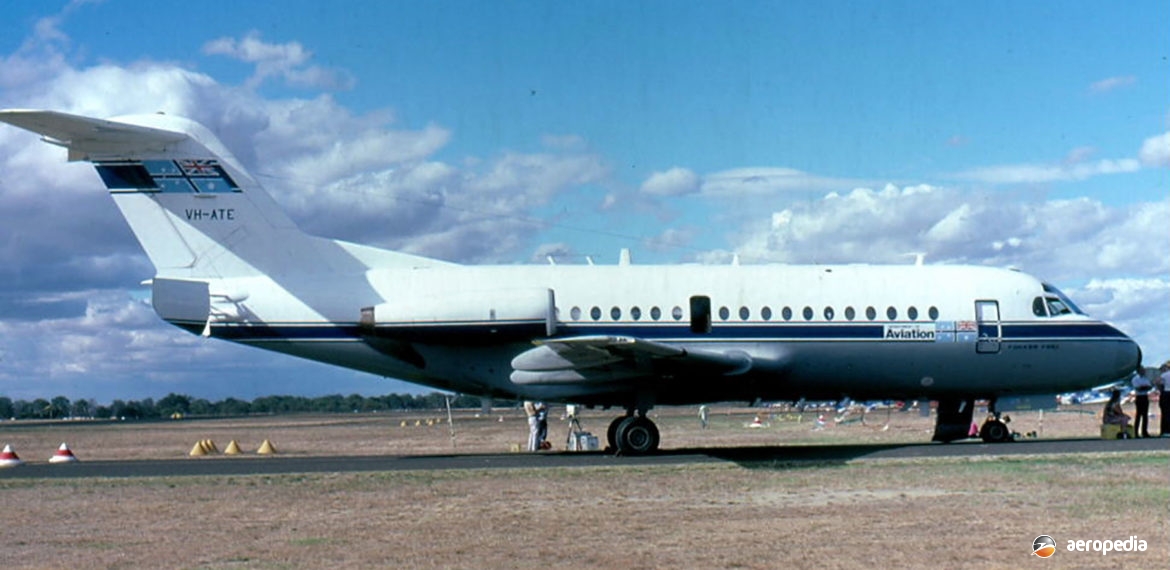Photograph:
Fokker F-28-1000 Fellowship VH-ATE (c/n 1108) at Mangalore, VIC in April 1985 (David C Eyre)
Country of origin:
The Netherlands
Description:
Short-haul commercial transport
Power Plant:
Two 9,850 lbst Rolls Royce Spey 555-15 turbojets
Specifications:
- Wingspan: 23.58 m (77 ft 4¼ in)
- Length: 21.4 m (89 ft 10¾ in)
- Height: 8.47 m (27 ft 9½ in)
- Wing area: 76.4 m² (822 sq ft)
- Max cruising speed at 6,400 m (21,000 ft): 849 km/h (528 mph)
- Economical cruising speed at 7,620 m (25,000 ft):
- 836 km/h (519 mph)
- Long-range cruising speed at 9,150 m (30,000 ft):
- 676 km/h (420 mph)
- Max operating ceiling: 10,675 m (35,000 ft)
- Range with max payload: 1,538 km (956 miles)
- Range with max fuel: 1,945 km (1,208 miles)
- Empty weight: 16,144 kg (35,517 lb)
- Max payload weight: 8,936 kg (19,700 lb)
- Loaded weight: 29,480 kg (65,000 lb)
History:
In April 1962 the Fokker company announced its intention to develop a short-haul jet airliner to complement its successful Fokker F-27 Friendship series. Production was launched in July 1964, and three prototypes were built, the first flown on 9 May (PH-JHG), the second on 3 August (PH-WEV), and the third on 20 August 1967 (PH-MOL). The first production aircraft, which became known as the Mk 1000, provided accommodation for 65 passengers five-abreast in one class. It was contemplated as an aircraft to fulfill the dual role of a replacement for the F-27 and to operate on routes requiring the benefit of pure jet operations.
The F-28 Fellowship series was developed and built in collaboration with the German companies Messerschmitt-Bolkow-Blohm and VFW-Fokker, and Short Brothers in the United Kingdom. Members of the consortium then built sections of the aircraft, final assembly taking place at Schiphol-Oost in Amsterdam. A deal was also arranged with Fairchild in the United States to build a shortened model known as the F-228 but this proposal did not proceed.
A number of variants were subsequently developed up to the 6000 series. The Series 2000 had the fuselage length increased by 2.21 m (7 ft 3 in) to increase passenger capacity to 79, and was flown for the first time on 28 April 1971. This was followed by the Mk 5000, which was a Mk 1000 with wingspan increased by 1.51 m (6 ft 11½ in), leading-edge slats, and the improved Rolls Royce Spey 555-15H engine. The Mk 6000 was actually the Mk 2000 with similar improvements to the Mk 5000. This gave the Mks 5000 and 6000 the ability to operate from shorter runways. The first Mk 6000 was flown on 27 September 1973.
The F-28 Fellowship was reasonably popular in this area over the years, the first seen being a Fokker demonstrator PH-MOL (c/n 11003) in February 1969, visiting both Australia and New Zealand. A total of 20 has operated in Australia. Two did not make it to Australia although registrations were allotted but not taken up, these being allotted VH-EWA (c/n 11173) and VH-EWB (c/n 11181) for East West Airlines.
MacRobertson Miller Airlines, which on 1 July 1981 changed its name to Airlines of Western Australia, received seven F-28-1000 aircraft: VH-FKA ( c/n 11021 – ‘RMA Pilbara’ – ex PH-ZAS); VH-FKB (c/n 11022 – ‘RMA Kimberley’ – ex PH-ZAT); VH-FKC (c/n 11025 – ‘RMA Arnhem Land’ – ex PH-EXF); VH-FKD (c/n 11026 – ‘RMA Goldfields’ – ex PH-EXA); VH-FKE (c/n 11040 – ‘RMA Gascoyne’); VH-FKF (c/n 11008 – ‘RMA Greenough’ – ex PH-MAT); and VH-FKG (c/n 11031 – ‘RMA Horrie Miller’ – ex F-BUTE). They operated until disposed of in 1995 and 1996.
The first VH-FKA arrived in Perth on 8 June 1970 and commenced services on 11 June. A chartered aircraft VH-MMJ ( c/n 11013 – ex PH-ZAH, LN-SUO) was returned to Amsterdam on the arrival of the company’s first aircraft. The second F-28 Fellowship VH-FKB arrived on 12 July, and the third VH-FKC on 20 October. The registration VH-FKF was allotted twice, firstly to (c/n 11008) and later to (c/n 11056), which in the event went to Air New Guinea as P2-ANW.
Ansett Airlines operated three with Airlines of New South Wales, VH-FKD (c/n 11357) entering service on the Sydney to Dubbo, Wagga Wagga and Broken Hill routes and was operating in a 58-seat configuration with a gross weight of 28,577 kg (63,000 lb). However, due to economic problems in the rural community, the services were not successful. The aircraft was withdrawn and joined the MMA fleet in Western Australia in 1971. However, things got better and VH-FKD re-joined Airlines of New South Wales in mid 1983 and extra services included Williamtown, NSW, and Coolangatta and Brisbane in Queensland. Ansett F-28s were also painted in ‘Ansett WA’ and ‘Ansett NT’ markings, and a few were used by Ansett Express on freight operations.
Three Series 1000s were registered to the Commonwealth Department of Transport & Communications: VH-ATD (c/n 11047 – ex PH-EXI), VH-ATE (c/n 11082 – ex PH-EXN) and VH-ATG (c/n 11084 ex PH-EXP) between 1976 and 1998, which were used for the calibration of airways equipment, but were also used for VIP duties. Based at Essendon, VIC they had multiple facility check-out and interference monitoring capabilities. They were obtained in 1976-1977 and were sold in the late 1980s and exported to Canada.
As noted above, one of the MacRobertson Miller aircraft VH-FKD was used by Airlines of New South Wales for a short period on the longer services within New South Wales, including the route to Broken Hill, when it was first introduced into Australian service. However, it returned to Western Australia where it and the other aircraft operated on the long haul routes within that State.

